|
|
|
|
Great Yarmouth
Today Great Yarmouth is known as a popular seaside
resort - famous for its promenade and its Pleasure Beach.
However, historically, Yarmouth was a strategically
important
port controlling the entrances to the rivers Bure, Yare
and Waveney. (The Bure enters the town from the north
while the Yare and Waveney converge from the south
through Breydon Water.) In the 19th Century Yarmouth was
also an important herring port - where tons of the
'silver darling' were landed.
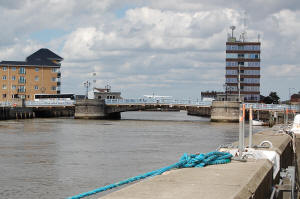
River Yare at Yarmouth
Daniel Defoe (1660-1731)
In 1724, Defoe visited
Yarmouth as part of his Tour Through the Whole Island of
Great Britain and was very impressed by what he saw.
He was quick to appreciate the town's
geographical location and how it controlled Norwich's
access to the North Sea.
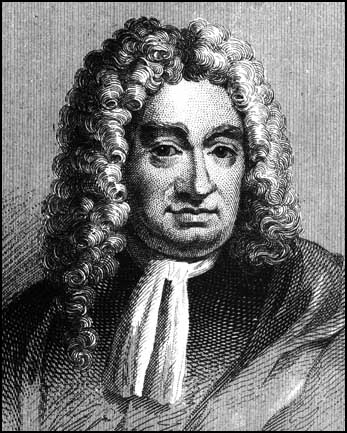
Daniel Defoe
|
|
'Yarmouth is an antient town, much older than Norwich;
and at present, tho' not standing on so much ground, yet
better built; much more compleat; for number of
inhabitants, not much inferior; and for wealth, trade
and advantage of its situation, infinitely superior to
Norwich. It is plac'd on a peninsula between the River
Yare and the sea; and two last lying parallel to one
another, and the town in the middle. The River lies on
the west-side of the town and being grown very large and
deep, by a conflux of all the rivers on this side the
county, forms the Haven; and the town facing to the west
also, and open to the River, makes the finest key in
England, if not in Europe, not inferior even to that of
Marseilles.' |
Great Yarmouth also provides the
starting point for Robinson Crusoe's journey in Defoe's
famous adventure story. The eponymous hero is anchored
in Yarmouth Roads awaiting a favourable wind. The Yarmouth Roads is a stretch of
(usually) safe water which lies just off the coast - slightly
inshore of Scroby Sands.
After leaving Yarmouth Roads, Crusoe's ship is then
wrecked in a storm off Winterton
but he makes it to the shore in a lifeboat and then
walks back to Yarmouth. Robinson Crusoe was published in 1719 is
often regarded as the first English novel.
|
|
'The sixth day of our being at sea we came into Yarmouth
Roads; the wind having been contrary, and the weather
calm, we had made but little way since the storm. Here
we were obliged to come to an anchor, and here we lay,
the wind continuing contrary, viz., at southwest, for
seven or eight days, during which time a great many
ships from Newcastle came into the same Roads...' |
See also King's Lynn. |
Charles Dickens (1812-1870)Charles Dickens visited
Great Yarmouth in 1849 - staying at the Royal Hotel on
Waterloo Road.
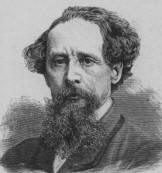
Charles Dickens
He only stayed for two days but the place must have
made a big impression on him for he was soon to use it
as the main setting for his semi-autobiographical novel David Copperfield.
An upturned boat on the beach, used as a
house, almost certainly provided the inspiration for Peggotty's
house.
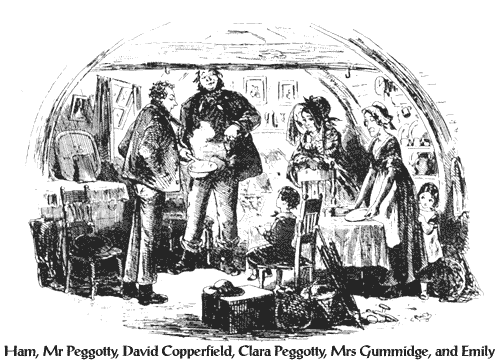
Inside Peggotty's House
Here is the passage from the novel where
David Copperfield first sees the house:
|
'Yon's our house, Mas'r Davy!'
I looked in all directions, as far as I could stare over
the wilderness, and away at the sea, and away at the
river, but no house could <i>I</i> make out. There was a
black barge, or some kind of superannuated boat, not far
off, high and dry on the ground, with an iron funnel
sticking out of it for a chimney and smoking very
cosily; but nothing else in the way of habitation that
was visible to me. |
As a visitor to Yarmouth, Dickens must also have been
conscious of
the pervading smell of fish - a feature which he
describes in the following section of the book:
|
|
'When we got into the street (which
was strange enough to me), and smelt the fish, and
pitch, and oakum, and tar, and saw the sailors walking
about, and the carts jangling up and down over the
stones, I felt I had done so busy a place an injustice;
and said as much to Peggotty, who heard my expressions
of delight with great complacency, and told me it was
well known (I suppose to those who had the good fortune
to be born Bloaters) that Yarmouth was, upon the whole,
the finest place in the universe.' |
David Copperfield
was born at Blundeston(e) which lies just over the
border in Suffolk.
|
|
Thomas Nashe (1567-1601) In 1599, the Lowestoft born poet
and dramatist Thomas Nashe had to leave
London following the publication of The Isle of Dogs.
Nashe had collaborated with Ben Jonson on the
writing of this satirical comedy.
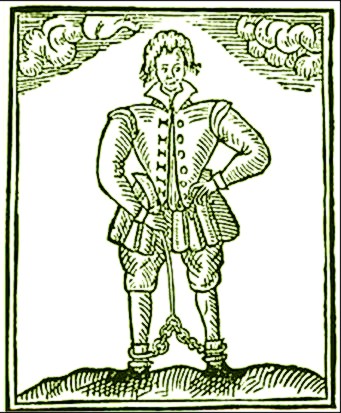
Thomas Nashe Nashe escaped to Great
Yarmouth where he wrote another satire - this time - one
about the red herring or kipper. It was entitled
Nashes Lenten Stuffe and here is an extract:
|
|
'A Fisherman of Yarmouth, hauing drawne so many herrings
hee wist not what to do withall, hung the residue that
he could not sel nor sped, in the sooty roofe of his
shad a drying: or say thus, his shad was a cabbinet in
decimo sexto, builded on foure crutches, and hee
had no roome in it, but in that garret or Excelsis,
to lodge them, where if they were drie, let them bee
drie, for in the sea they had drunke too much, and now
hee would force them doo penance for it.' |
|
Anna Sewell (1820-1878)
Anna Sewell - the authoress of
Black Beauty - was born in Great Yarmouth at this house
on Church Plain in 1820. However, she didn't write the
book until she was 57 years old and living in
Old Catton
near Norwich. She only wrote one book during her
lifetime, but it has remained a children's classic ever
since. The house is now used as a restaurant. Anna
Sewell died shortly after Black Beauty was
published and she was buried in the graveyard of the
Quaker Chapel at Lamas.
|
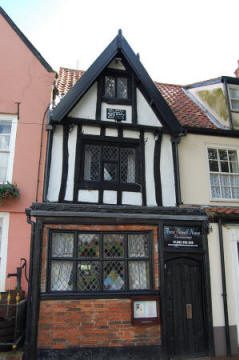
Birthplace of Anna Sewell |
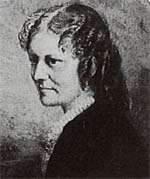
Anna Sewell |
David Service (1776-1828)David Service was
born in Scotland but moved to Yarmouth where he worked
as a shoemaker in Row 27. One of his early poems (The
Caledonian Herd Boy) caught the eye of the eminent
physician Dr Thomas Girdlestone who introduced him to
influential friends - which kick-started his career.
Service then wrote a poem about the death of Princess
Charlotte - who had died in childbirth - and also an ode
to local mathematician Adam Glendenning - which further
enhanced his reputation. However, he was unable to
handle the fame and the money and soon became destitute
- owing large amounts of money. He was finally put in
the stocks in Yarmouth market place.
In 1822, though, he reappeared publishing A Tour
in Pursuit of Ideas - which was an odyssey round the
taverns and inns of Yarmouth. The poem was an instant
success and Service was once again 'in the money'.
Unfortunately, he soon squandered the new income and
this time was consigned to the workhouse. He died aged
52 and is buried in St. Nicholas' churchyard.
Also buried in the churchyard are many of the victims
of the 1845 Yarmouth suspension bridge disaster. The
bridge collapse, which cost the lives of 77 people, is
depicted on some of the headstones.
|
|
George Borrow
(1803-1881) The travel writer and novelist lived at 169 King Street from 1853-55
(where he completed Romany Rye) and then at 37-9 Camperdown Place
from 1856-9 - now an hotel. Borrow, who was an energetic person, loved to
bath in the sea while living in the town. Borrow's main
influence was undoubtedly Daniel Defoe - who also has
connections with Yarmouth - see above. See also
Dereham and
Norwich
|
|
Arthur Ransome (1884-1967) In Coot Club Mrs Barrable
and the children sail through Yarmouth on their way to
Beccles. The grand finale of the book also takes place
on Breydon Water near Yarmouth when the Teasel
and the Titmouse run aground in the fog and the
Margoletta and her crew of Hullabaloos close in
on them. Fortunately, though, the Hullabaloos hit a post
and the Margoletta is wrecked before they can get
their hands on Tom Dudgeon. (Tom originally set their
cruiser adrift to protect a coot's nest near
Horning.)
Breydon Water was also the stamping ground of the
Norfolk naturalist Arthur H Patterson who inspired Ted
Ellis - another Norfolk naturalist.
|
Links:
More photographs of Great Yarmouth |
|
|
|

